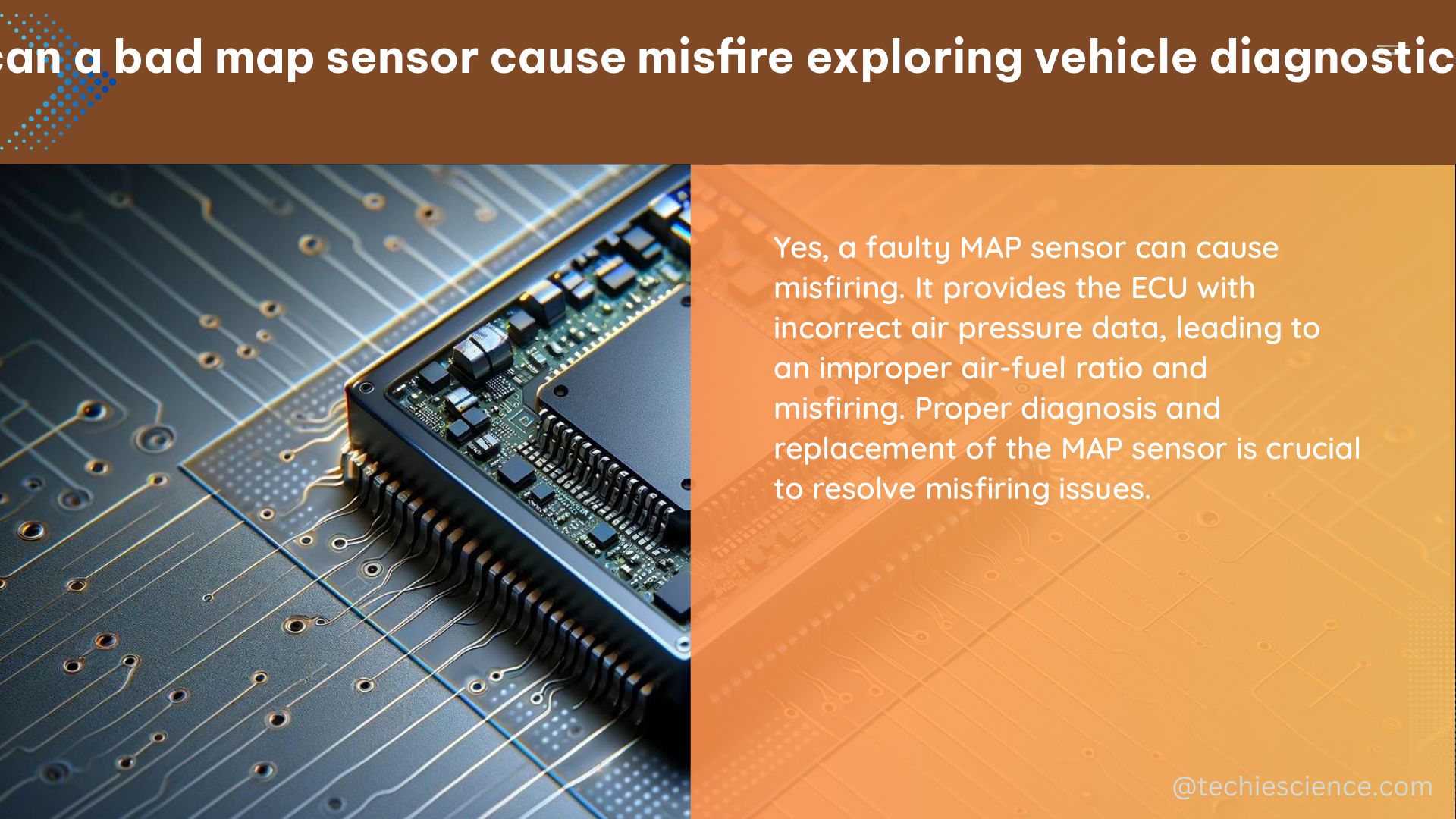A malfunctioning Manifold Absolute Pressure (MAP) sensor can indeed lead to engine misfiring, as it plays a crucial role in the engine control system’s fuel injection and ignition timing adjustments. This comprehensive guide will delve into the intricacies of how a bad MAP sensor can cause misfiring, the diagnostic tests to identify the issue, and the steps to resolve it effectively.
Understanding the Role of the MAP Sensor
The MAP sensor is a critical component in modern engine management systems, responsible for measuring the pressure inside the engine’s intake manifold. This pressure data is then used by the engine control unit (ECU) to adjust the fuel injection and ignition timing, ensuring optimal engine performance and efficiency.
When the MAP sensor is functioning correctly, it provides the ECU with accurate pressure readings, allowing the engine control system to make the necessary adjustments. However, if the MAP sensor is faulty, it can supply the ECU with incorrect pressure information, leading to improper fuel injection and ignition timing, which can ultimately result in engine misfiring.
Symptoms of a Bad MAP Sensor

A malfunctioning MAP sensor can manifest in various symptoms, including:
-
Misfiring: As mentioned earlier, a faulty MAP sensor can cause the engine to misfire, leading to rough idling, hesitation, and reduced engine performance.
-
Poor Fuel Efficiency: Incorrect fuel injection due to a bad MAP sensor can result in excessive fuel consumption and reduced fuel efficiency.
-
Engine Stalling: Inaccurate pressure readings from the MAP sensor can cause the engine to stall, particularly during acceleration or under heavy load.
-
Difficulty Starting: A faulty MAP sensor can make it challenging to start the engine, especially when the engine is warm.
-
Increased Emissions: Improper fuel-air mixture caused by a bad MAP sensor can lead to increased emissions, including black smoke from the exhaust.
-
Check Engine Light Illumination: Most modern vehicles will illuminate the check engine light when the ECU detects an issue with the MAP sensor, often triggering diagnostic trouble codes (DTCs) related to the sensor.
Diagnosing a Bad MAP Sensor
To determine if a bad MAP sensor is the root cause of the misfiring issue, you can perform the following diagnostic tests:
-
Voltage Output Test: Use a multimeter to measure the voltage output of the MAP sensor. A healthy MAP sensor should produce a voltage between 0.45V and 5V, depending on the engine load and RPM. If the voltage reading is significantly different or erratic, it indicates a faulty MAP sensor.
-
Trouble Code Scan: Use an OBD-II scanner to check for any diagnostic trouble codes related to the MAP sensor, such as P0105, P0106, P0107, P0108, and P0109. These codes can provide valuable information about the specific issue with the MAP sensor.
-
Vacuum Leak Test: A vacuum leak in the intake system can also cause similar symptoms to a bad MAP sensor. Use a vacuum gauge to check for any leaks in the intake system, which can affect the pressure readings and lead to misfiring.
-
MAP Sensor Replacement: If the voltage output test and trouble code scan indicate a faulty MAP sensor, the best course of action is to replace the sensor with a new one that meets the vehicle’s specifications.
Replacing the MAP Sensor
When replacing the MAP sensor, it’s essential to ensure that the new sensor is compatible with your vehicle’s make, model, and year. Refer to the vehicle’s service manual or consult with a professional mechanic to identify the correct replacement part.
During the replacement process, follow these steps:
- Disconnect the negative battery cable to prevent any electrical issues.
- Locate the MAP sensor, which is typically located on the intake manifold or near the throttle body.
- Disconnect the electrical connector from the MAP sensor.
- Remove the mounting bolts or screws that secure the MAP sensor to the intake manifold.
- Install the new MAP sensor, ensuring it is properly seated and secured.
- Reconnect the electrical connector and the negative battery cable.
- Clear any diagnostic trouble codes and perform a test drive to ensure the new MAP sensor is functioning correctly.
Preventing Future MAP Sensor Issues
To minimize the risk of future MAP sensor-related problems, consider the following preventive measures:
- Regular Maintenance: Follow the manufacturer’s recommended maintenance schedule, which may include periodic inspection and replacement of the MAP sensor.
- Avoid Tampering: Do not attempt to modify or tamper with the MAP sensor, as this can lead to further issues and potentially void the vehicle’s warranty.
- Address Underlying Issues: If the MAP sensor is replaced but the misfiring issue persists, it’s essential to investigate and address any underlying problems in the engine or fuel system.
By understanding the role of the MAP sensor, recognizing the symptoms of a bad sensor, and following the proper diagnostic and replacement procedures, you can effectively resolve engine misfiring issues and maintain the overall health of your vehicle’s engine management system.
References:
- Making Sense of Your Sensors: MAP Sensor
- How to Check if Your MAP Sensor is Bad
- MAP Sensor Issue
- MAP Sensor Code and Stalling
- How to Test a MAP Sensor

The lambdageeks.com Core SME Team is a group of experienced subject matter experts from diverse scientific and technical fields including Physics, Chemistry, Technology,Electronics & Electrical Engineering, Automotive, Mechanical Engineering. Our team collaborates to create high-quality, well-researched articles on a wide range of science and technology topics for the lambdageeks.com website.
All Our Senior SME are having more than 7 Years of experience in the respective fields . They are either Working Industry Professionals or assocaited With different Universities. Refer Our Authors Page to get to know About our Core SMEs.